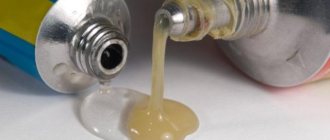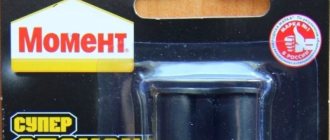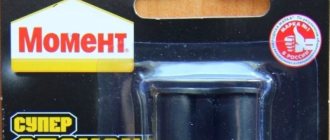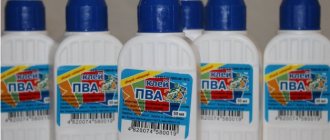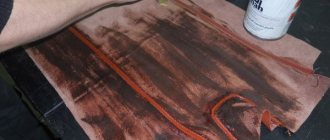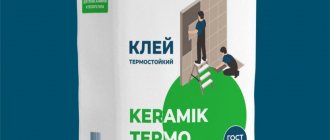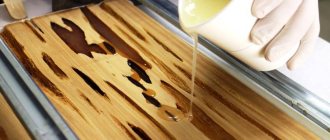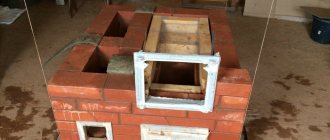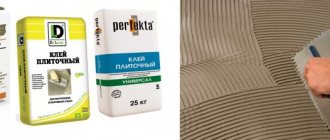Compound
The basis of the composition is epoxy resin. Before gluing it must be mixed with a hardener.
Such an additional component may be polyethylene polyamine, triethylene tetramine or anhydrite. When combined with the resin, the hardener forms a durable polymer substance. The hardener can also be polyamine, carboxylic acids, aminoamides. Hardeners account for 5-15% of the composition. To improve the toughness characteristics, rubber is added to the mixture. To reduce the flammability of the product, organophosphorus modifiers are mixed into it, and laproxy increases the elasticity of the glue.
One-component adhesives contain solvents. On contact with air they evaporate and the mixture hardens. Acetone, xylene, and alcohol can be added to the glue as a solvent. Its content in the composition does not exceed 3%.
- Additionally, synthetic rubber, formaldehyde resin, fiberglass, metal oxides, metal powder, clay or chalk can be mixed into the adhesive mixture.
- To impart plasticity to the mass, its composition can be supplemented with plasticizers that prevent the glue from crumbling after crystallization (for example, phthalic or phosphoric acid). After applying glue with a plasticizer, the seam becomes more elastic and durable. Add. components in epoxy can make up 5-50% of the bulk. While the proportion of fillers that improve performance can reach up to 300%.
Possible components and additives
By adding various components to the adhesive, you can improve its performance.
- Powdered aluminum. Increases thermal conductivity and strength of the seam.
- Asbestos improves resistance to temperatures and makes the seam harder.
- Iron oxide colors the seam red and increases its fire resistance.
- Iron powder increases the coefficient of thermal conductivity and heat resistance.
- Soot turns the glue line black.
- Silicon dioxide makes the composition less viscous, but more durable after drying.
- Titanium dioxide turns the transparent glue white.
- Aluminum oxide increases the strength of the composition and its dielectric characteristics.
- Glass fibers and wood chips help add volume to the mixture. This is necessary when filling large voids with epoxy.
Glue storage
Factory containers are used to store the glue. When pouring into other containers, polymerization and loss of material properties may occur. The manufacturer selects container materials that do not react with epoxy glue. Before packaging, dust and other substances are removed from the container. The container is placed in a cool, dark place. The goal is to prevent sunlight from reaching the epoxy adhesive. There should be no sudden changes in temperature and humidity in the storage room. The optimal temperature is 20 degrees. The adhesive is suitable for use throughout its shelf life. If after its completion the glue has not lost its properties, then it can also be used.
Areas of use
Epoxy composition has a wide range of applications. Work with glue is carried out in the following areas.
- In construction. The glue is used to fill cracks in concrete, cement screed, reinforced concrete beams, and to seal seams in panel houses. Its use provides the structure with additional strength. They connect iron and concrete parts in the construction of bridges. Epoxy is used to seal insulation, sandwich panels, chipboard, to reduce heat loss, and to finish surfaces with tiles or mosaics. Epoxy is included in primers, putties, and tile mixtures.
- In mechanical engineering. You can glue brake pads and attach plastic and metal parts. The composition is used for repair work, for joining metal or plastic parts. Since the glue is waterproof, it can be used to seal holes in the body or fuel tank, or to restore skins.
- In shipbuilding and aircraft construction. When boats are built, the hull is treated with epoxy to make it waterproof. Fiberglass parts and fastenings of technological units are connected. During aircraft assembly, thermal protection elements are attached. The product is used in the production and fastening of solar panels.
- At home. The composition can be used to repair furniture, shoes, plastic, metal and wooden elements, and to repair equipment. Epoxy is used to seal cracks in glass vases, lampshades, and aquariums. Even parts broken into fragments can be returned to their original shape. The product is used to glue chips of porcelain stoneware, seal cracks in ceramic tiles, and attach hooks or holders to walls. Fashionable architectural designers use epoxy to fill countertops and create designer furniture. It is used in handicrafts and in making souvenirs. The composition is used to secure fasteners in the manufacture of jewelry or hair accessories. They are used to glue sequins, beads, half-beads, lace, satin ribbons, leather, polymer clay, etc.
Properties
- Seam elasticity. Even if the glued surfaces have slight mobility, the seam will not crack or collapse. The elastic seam is not damaged or chipped when drilling or grinding the surface.
- Versatility. Most known materials can be glued.
- Since the adhesive contains solvents, it cannot be used to glue silicone, polyethylene and Teflon bases; there is a high risk of their destruction. The hardened layer of epoxy can be painted or varnished. In addition, it is resistant to solvents, alkalis and oils.
- Frost resistance. The seam does not lose its strength characteristics when the air temperature drops to -30°C, which is why the product can be used for outdoor work.
- Waterproof. After complete hardening, the seam is not susceptible to moisture, water vapor, or condensation.
- Fast drying. The initial coupling takes no more than two minutes. After complete polymerization, it is almost impossible to detach the glued parts.
- Heat resistance. The composition can withstand high temperatures up to +250°C. There are ultra-heat-resistant adhesives that can withstand up to +400°C.
Kinds
There are 3 basic parameters by which epoxy adhesives are classified:
- compound;
- final consistency;
- hardening method.
By composition
- One-component epoxy adhesive. This is a transparent mixture consisting of liquid resin or resin-containing solvent. The glue is packaged in small tubes and does not require preparation before use. The one-component product glues small parts well and is used to seal joints in pipes or cracks and gaps. Most compositions harden on their own. But some brands may only set after high heat.
- Two-component epoxy adhesive. This is the most common form of release. It consists of two components, each of which is packaged in a separate tube. The first tube contains the resin, the second contains the hardener. The second component may have a liquid or powdery consistency. Before use, the resin is mixed with a hardener. The components must be poured into one container and mixed with a spatula. The 2-component composition is applied to the surface within 1-2 minutes after preparation, since after this time it hardens and loses its properties.
Two-component composition in a syringe
By consistency
- Liquid. Such epoxy adhesives need to be squeezed out of the tube. Can be used sparingly as it can be applied to spots. Allows you to glue small parts. Liquid adhesives are often available in syringes. This is a ready-to-use composition.
- Pasty. The product is in the form of a plastic mass with a texture similar to ordinary plasticine. To work, you need to cut off a sufficient amount of paste, knead it and lightly moisten it with water. The finished composition should have a thick consistency. After preparation, it is applied to the surface to be glued.
Epoxy plasticine
By curing method
- Mixtures based on liquefied resin, aliphtic polyamide and plasticizers set quickly, but their complete hardening at t=+20°C occurs in 1-3 days. They take a long time to structure. To increase the strength of the seam, after application it must be thermally treated. Seams not treated with high temperatures are resistant to aggressive acid-base environments. But without heat treatment, the seam will be poorly resistant to prolonged exposure to moisture. This must be taken into account when gluing wooden and other hydrophilic substrates.
- Modifications of adhesive compositions can harden at temperatures from +60 to +120°C. They are used to glue bases, the material of which is characterized by impact strength and increased resistance to the influence of solvents such as oil or gasoline.
- Ultra-strong high-temperature adhesives, for the hardening of which it is necessary to expose the seam to temperatures ranging from +140 to +300°C. Connections of this type have electrical insulating and heat-resistant characteristics.
Scope of application and types
Since epoxy adhesives are multi-purpose, they have found application in the following industries:
- Construction – combining panels, reinforced concrete bridge systems.
- Mechanical engineering – production of scientific and technical equipment, grinding instruments, etc.
- Shipbuilding – installation of fiberglass vessels, installation of fastenings.
- Assembling a car - gluing plastic parts to metal, securing brake pads.
- Installation of aircraft units, in the production of good batteries, etc.
According to the mixture of glue: durable, paste-like, viscous solution, pigment, film.
Film adhesive is a material reinforced with some fabrics.
The paste mixture is sold ready-made or in the form of components for mixing. If there is no heating during preparation, then mixing is done directly before use.
In order to obtain an optimal connection result, the planes must be processed before gluing. Treatment is acceptable with sandpaper, sand, ultrasound, degreasing with a solvent or pickling in an acid bath. The strength of the connection and its stability during operation depend on this stage.
Possessing rare adhesive qualities, epoxy adhesives are used where the transfer of large overloads is necessary. They are used instead of the classic automatic fastening of various elements. The combined (glued) planes look exactly like a common whole.
The acquired associations are characterized by significant strength, heat and water resistance, and stability to the influence of aggressive environments. Their use is possible in a wide range of temperatures and they are suitable for the purpose of firmly combining elements from almost different materials used.
Specifications
| Characteristic | Meaning |
| The basis | Epoxy resin |
| Additional components | Modifiers, hardener, solvent, fillers, plasticizer. |
| Color | White, transparent, yellowish. For metal bases, the adhesive may have a silver, gray or brown tint. In rare cases, the composition may be pink. |
| Working temperature | From +10°С, the higher, the faster the rate of hardening of the composition |
| Curing time | Depends on the composition of the product. Ranges from 3 hours to 3 days. |
| Operating temperature | -20…+120°С. Particularly durable compositions can be operated at t=+250°C |
| Hazard Class | Class 3 - a low-hazard product that can cause irritation and an allergic reaction to the skin. |
| Environmental friendliness | Toxic product, do not allow it to enter water bodies. |
| Shelf life of the prepared product | From 5 minutes to 2 hours, depending on the manufacturer. |
| Composition strength | 100-400 kgf per 1 sq.m. |
| Average density per 1 cubic meter. | 1.37 t. |
| Elasticity upon impact or displacement of the seam | 1000-2000 MPa |
| Solvents | Toluene, acetone. After crystallization, the product is resistant to alkalis, salts, kerosene, gasoline, and acids. |
| Release form | For gluing small surfaces, you can buy epoxy in 6 or 25 ml syringes. The universal composition is available in containers of 140, 280 g, 1 kg. Epoxy like cold welding can be bought in tubes of 45 or 70 ml, it is also available in buckets and bottles of 250 or 500 g. For industrial purposes, the product is produced in barrels of 15, 19 kg. |
Consumption
The consumption of epoxy-based adhesive will depend on the thickness of the applied layer.
The average consumption per 1 m2 with a layer of 1 mm is 1.1 kg.
If porous substrates such as concrete, wood or wooden slabs are pasted over, the consumption increases. To fill voids with a volume of 1 cm cubic. you need to use 1.1 g of the mixture.
How long does it take to dry?
Drying time depends on the ambient temperature and the ratio of the main components in the composition. To speed up the setting of the product, you need to add more hardener to it. To increase the speed of hardening, the adhesive joint can be heated after setting. If you increase the heating temperature, the composition hardens faster.
Epoxy glue dries differently. It all depends on its type.
- Cold welding hardens in 5-20 minutes.
- Liquid mixtures become thick after an hour, set after 2 hours, and completely polymerize within a day.
If the glue does not harden (or takes a very long time to dry), it is possible that it is expired, or the proportions when preparing the mixture were not met.
You should not carry out gluing at sub-zero temperatures, since the adhesive seam does not normally crystallize. To speed up hardening, it is better to carry out work at temperatures from +10 to +30°C.
Temperature
Most brands, after hardening, can withstand heating temperatures up to +150...+180°C, without reducing the strength characteristics of the seam.
Some adhesives are characterized by increased heat resistance, so they can withstand +250°C. There is a type of glue that has increased heat resistance; it holds its shape when exposed to a temperature of +400°C for a short time.
For normal glue hardening, it is enough that the temperature is from +20 to +23°C. Some brands can harden at +10...+15°C.
If the composition needs to be made more liquid, the resin must be heated in a water bath, with a melting point of 50-60°C. After melting, the epoxy is easily drawn up with a syringe and applied pointwise to the prepared surfaces.
On average, the operating temperature is +10...+30°C, but depending on the brand it may differ.
Existing varieties
The central component of the glue is epoxy resin. The material is a synthetic oligomer that is used without additional substances. Epoxy resin is an indispensable component of paints and finishing materials. The consistency of the resin depends on the material it is a part of.
By composition
The epoxy adhesives market is represented by two groups:
- one-component;
- two-component.
The one-part epoxy adhesive is ready for bonding once the storage container is unsealed. The composition, in addition to epoxy resin, contains organic solvents that prevent polymerization. The one-component composition is used for gluing small parts, sealing plumbing seams and connecting pipes. Another area of household use is handicrafts. You cannot store the glue in an open state, because it dries quickly, which is a disadvantage of one-component epoxy glue. Among the advantages of the material, it is important to note:
- reusable;
- ease of application;
- affordable price;
- ease of storage;
- non-toxic;
- strength after polymerization.
The one-component composition hardens at room temperature, so no heating devices are required. The two-component formulation comes in two separate tubes. One tube contains a substance based on epoxy resin, and the second contains a hardener that performs polymerization. The hardener is available in liquid or powder form. The advantages of the composition are:
- gluing two different materials;
- strength and elasticity of the connection;
- ease of application;
- no harmful emissions.
Two-component epoxy adhesive holds metal, wood, plastic and glass parts in place. The materials are combined in any sequence, which does not affect the bonding strength. The connection maintains elasticity, which is important under vibration loads. The glue is applied with a small spatula or stick. Before applying to the damaged area, mixing the two components is required. A correct calculation of the amount of hardener added to the base composition is required. If there is an excess of hardener, the “survivability” of the solution will be low, polymerization occurs quickly, which complicates gluing. A lack of hardener prevents the development of strength, which will lead to an unreliable connection of parts.
By consistency
Adhesives differ not only in composition, but also in consistency. Depending on the viscosity of the glue, there are:
- gels;
- liquids;
- plastic masses.
The gel has less fluidity than liquid, so it is easier to apply to areas with major damage. Adhesives with gel compositions are consumed more economically than liquid compositions. Deep damage requires intense fluidity of the composition to envelop the rupture site. Liquid adhesives are easier to apply and cover the treated area on their own. The polymerization time of liquid adhesives is longer than that of gel adhesives. The plastic masses of epoxy adhesives are a substance similar to plasticine. Components are supplied in separate packages or in one package. If it is one package, then the hardener is on top of the epoxy component.
To begin polymerization, the hardener and epoxy part are thoroughly kneaded by hand. The components are mixed until smooth. After this, you have fifteen minutes to apply glue to the damaged area. Another name for two-component elastic compounds is cold welding. Plastic adhesive is suitable for gluing wooden, metal and plastic surfaces. The disadvantage of this method is the protruding mass of glue after polymerization.
The difference between epoxy glue and resin
Epoxy resin in its composition is a polymer combined with a hardener, and the adhesive based on it is a complex compound that includes modifiers and fillers.
You can distinguish one from the other by certain characteristics.
- Hardening speed. The manufacturer indicates on the glue packaging the exact time for its hardening, which cannot be accelerated or slowed down. The rate of polymerization of the resin can be influenced by external influence.
- Color. The resin is initially transparent. Over time, the shade changes only slightly. The glue is also colorless at first, but over time it turns yellow.
- Scope of application. Resin is added in the manufacture of plastic, putty, primers, paints, and is also used for filling. Glue is used only for repair and construction work.
Stamps
| Name | Description |
| Contact | Effectively used in rooms with high humidity. They can be used to seal pipes, showers, bathtubs, and toilets. |
| Henkel Moment | Two-component “Moment Super Epoxy” adhesive is produced in tubes or syringes with a volume of 5 g or more. The Epoxylin composition is also sold in 30, 48, 100 or 240 g. The product is reliable, durable and easy to use. |
| Super-Grip | This is an equal-component epoxy adhesive containing mineral fillers that increase the strength of the joint. Glues almost any materials. |
| Bison | Transparent gel consisting of two components. It can be used to fill voids, cracks, chips, and restore parts to their original shape. |
| Class | The tool is similar to the previous one. Glues metals, alloys, is used for repairing cars, gluing pipes or sinks. |
| Second | Bonds all surfaces in just three minutes. |
| Novocolor station wagon | It shrinks slightly and has high adhesive ability with different substrates. The product can be used to glue large cracks and chips. |
| Metal Bond | Initial coupling in just 5 minutes. You can glue metal to wood, plastic or other substrates. |
| Compound K-153 | For connecting metal structures that are constantly exposed to moisture or petrochemical products. |
| Ultima (two-component adhesive) | Used in decorative facing works. They can repair vehicles, boats, boats, household appliances or plumbing fixtures. |
| Poxipol | It crystallizes within 10 minutes after mixing, so you need to work with it quickly. |
| EDP | Bonds any surface, from glass to metal. Has good value for money. |
| Epoxy steel | A product for any base. It belongs to autochemical products, since it is often used in car repairs. |
| DoneDeal Epoxy Adhesive | 2-component epoxy adhesive, available in syringes. Creates a tight, airtight, waterproof seam. |
| BisonEpoxy 5 min | Reliably adheres to any surface and has a high polymerization rate. |
| Abro | This is a cold welding that connects bases made of any materials. Can be produced in white and black. |
| Novol Plus | A resin-based product combined with a hardener and fiberglass. You can glue large chips, cracks or defects. |
| Uhu | Connects plastic, metal or used as a fill. |
| Defense-EC | Epoxy resistant to chemicals. Available in 10 kg buckets. Most often used in production. |
| Epoxy Titan | Equivalent product. Has increased strength and resistance to impact loads. Sold in blisters of 20 and 200 ml, in buckets of 2 liters. |
Epoxy adhesives from Moment
EDP
Two-component Poxipol
Top best
The stores have a large selection of epoxy compounds from imported and domestic manufacturers:
- Contact – transparent epoxy glue. Contains: poly epoxy resin, hardener. For use in household repairs. The seam is resistant to aggressive environments (exposure to oil, gasoline, water), does not shrink in any way, and does not expand. Perfectly fills vacuums and cracks. After drying, the product can be used at temperatures from –30 degrees to + 150 degrees. Glass, metal, wood, porcelain can be bonded.
- Moment Super Epoxy is an epoxy adhesive with many functions. It has a colorless structure, has superpowers, glues almost all materials, does not spread out and does not shrink when drying. Suitable for outdoor use. After drying, you can paint over, drill, etc. When the parts are mixed, curing begins within five minutes and high reliability is achieved within an hour. Do not use with polyethylene, Teflon, polypropylene or surfaces that will come into contact with food.
- TechnoNIKOL is a thixotropic epoxy adhesive with two components. The seam is resistant to bending and compression. Provides high adhesion to smooth surfaces. Used for repairing concrete structures, columns, curbs. Fills voids, gaps, cracks. Connects load-bearing and repaired concrete elements. Available in metal and plastic containers.
- G/Flex is an epoxy resin designed for permanent and water-resistant bonding of fiberglass, ceramics, and wood. It has higher elasticity than conventional epoxy or polyester resin, but is thicker and tougher than sealants. Used for connections that will absorb stress, increase, contraction, ripple, shock. After connecting the elements, working time is 45 minutes at room temperature. Hardening occurs after 7 hours, after 24 hours the glued elements can be used.
- Poxypol - two components. Consists of oligomers. The package contains two tubes. Before use, the contents are mixed in equal proportions. When mixed until smooth, a white adhesive composition is obtained. Bonds ceramics, metal, wood, concrete, plastic, glass, rubber. Hardens when exposed to water or oils. You can correct the seam within the first 10 minutes after application. Complete hardening occurs within a day.
Instructions for use
To glue materials, you need to first prepare them, then dilute the glue and only then start gluing.
First, dirt, dust, grease and oil stains must be removed from the surface to be pasted, and then completely degreased. Next, the surface is dried, although there are brands of epoxy adhesives that can paste over wet substrates. To increase the adhesive properties of the surface, it can be wiped with sandpaper after drying.
How to properly dilute
How to use epoxy glue and the exact proportions for its preparation are indicated in the instructions. The usual ratio of resin to hardener is 10 to 1. Sometimes it is necessary to prepare in a ratio of 5:1.
At home, it is better to prepare the glue in a separate container, which will then not come into contact with food. A disposable container is suitable for mixing.
- First, the resin is squeezed out of the tube.
- Then the hardener is added.
Mix the ingredients carefully and slowly to prevent a strong thermal reaction in the container. Mixing can be done with a wooden stick or spatula.
If the resin is too thick, it will be difficult to dilute with the hardener. In this case, the component must be dissolved in a water bath at a temperature of up to 50-60°C. To easily dilute the mixture to a uniform consistency, you can place the tube of resin in a pan of hot water before mixing. At the same time, do not allow boiling water to come into contact with the composition, so as not to deteriorate its characteristics.
Since the prepared mixture hardens quickly, you need to mix at a time only the amount that you have time to use before it initially dries.
How to glue
After preparing the surfaces, they need to be lubricated with the prepared glue and pressed tightly against each other. You need to hold them for about 10 minutes. Afterwards, leave until completely hardened (about a day).
For additional fixation, a rope, a vice, or weights can be used.
If small parts are connected, the composition can be applied pointwise with a syringe. The glue is applied to large areas with a brush.
If epoxy is used as a fill, the mold is prepared. Its bottom and sides are treated with fats. Afterwards, the mold is filled with glue and remains in it until completely hardened.
To speed up polymerization, three hours after pouring the glue into the mold, it is sent to the oven for heating. Without additional heating, the glue in the mold hardens no earlier than after a week. If a mold with a thickness of more than 2 mm is poured, then everything is done in stages. After each stage, you need to wait until the previous layer polymerizes.
How to dilute it to a liquid state
A solvent is used to dilute it to a liquid state.
Acetone, xylene, alcohols, and other organic compounds can dissolve epoxy glue.
The amount of thinner should not exceed 3-5% of the dry volume of the resin, as this may negatively affect the adhesive qualities of the composition.
You can dissolve the epoxy in a water bath, heating it to a temperature of 50-60°C.
How to dissolve hardened epoxy glue?
For this purpose, special aggressive compounds are used. For those asking how to dissolve epoxy glue, we can recommend using:
- acetone;
- nail polish remover;
- toluene;
- butyl acetate
It is necessary to moisten the seam generously with solvent and wait a little. Use a spatula or some other hard object to try to clean out the glue, removing its remnants with paper or a suitable rag. This method always works and provides the opportunity to completely remove the adhesive composition. However, if the surface is varnished or coated with paint, this may lead to damage to the product.
Security measures
During work, the room must be thoroughly ventilated. It is better to do gluing in the fresh air. These precautions are necessary because the epoxy mixture produces toxic fumes.
- You need to glue in thick clothing, with a respirator or protective mask on your face.
- Hands are protected with gloves.
- If the mixture gets on exposed skin, it should be washed off immediately with soap and water.
- The container in which the composition is mixed is thrown away after use. Food and drinking water cannot be stored in it, since even a small dose of glue entering the body can cause poisoning.
How to wash
If the glue gets on a surface that is not to be glued and has not yet had time to harden, it can be cleaned with a soap solution. Stubborn residues can be removed with acetone. The hardened mixture can be removed with liquid vegetable oils, under the influence of which it softens and peels off.
- Freezing. Epoxy can withstand low temperatures down to -20°C, so freezing it in a home freezer is ineffective. It must be removed with an aerosol refrigerant. If you spray it on the adhesive surface, it will become brittle. Afterwards, you need to remove the glue with a spatula or a blunt knife. Removal must be done carefully to avoid injury from glue fragments.
- Heat. The glue softens when heated with a household hair dryer or iron. Solid heat-resistant layers must be heated with a hairdryer with heated air flow at the maximum level for several minutes. The softened areas are scraped off with a spatula. Heat until all excess residue is removed. If epoxy drips onto the fabric, it needs to be heated with an iron, placing a cotton rag on the front side of the material.
- Scraping. Hard, scratch-resistant surfaces can be cleaned of the adhesive mixture mechanically. Any metal tool can be used for this.
- Exposure to chemical solvents. This method cleans wear-resistant materials that are not exposed to aggressive environments. Acetone, alcohol, butyl acetate, aniline, and toluene can be used as a diluent. You need to moisten the contaminated area with any of these products, wait until the glue softens and remove its remains mechanically. You can remove glue from mirror surfaces with acetic acid.
Storage
Epoxy should be stored in its original packaging at air temperature from +20 to +25°C. The product must be placed in a vertical position in a dry place.
The tube with the mixture should not be placed in direct sunlight; it should also be stored away from children and away from food.
If the container is damaged, the glue will lose its properties.
Shelf life depends on the manufacturer. May last from 1 to 3 years. After this period has expired, the quality of the glue may deteriorate slightly. The fresher the components of the adhesive mixture, the better the polymerization process of the composition, the faster the glue and the surface adhere, and a stronger seam is obtained. If there is still some of them left in the original packaging after mixing the components, you need to store the tubes with resin and hardener in the refrigerator. You must first remove as much air as possible from the tubes. The prepared mixture cannot be stored for long periods of time. After use, any remaining glue must be disposed of.
How to use Epoxylin Duo correctly
In order to use the adhesive substance correctly and prevent unnecessary overuse, it is worth learning how to use such glue correctly. Read the instructions for using it:
- The surface to be treated is thoroughly cleaned of all contaminants and layers of paint. To remove dried particles, use fine sandpaper. For complete cleaning, treat the surface with solvent.
- In a plastic container, combine the adhesive substance with the hardener. The catalyst is included along with the glue. Substances combine in equal proportions.
- Using a special spatula, which is also included in the general packaging, the compositions are thoroughly mixed until smooth.
- The resulting mass should be used within 5–7 minutes after preparation. You cannot store the finished substance - the glue will lose all its declared properties.
- The mixture is carefully applied to the two surfaces to be glued. The parts of the product are pressed tightly. After 2-3 minutes they can be released and allowed to dry.
Remember that the glued surfaces must not be moved or moved until the adhesive substance has completely cured . Otherwise, you will end up with an uneven seam, and the entire structure will become fragile.
Advice. When working with Moment Epoxylin Duo glue, be sure to use personal protective equipment: mask, gloves and goggles.
The adhesive mass is a strong allergen and, if inhaled, can provoke allergic reactions. The adhesive composition is aggressive and causes burns if it comes into contact with the skin. This should also be kept in mind.
